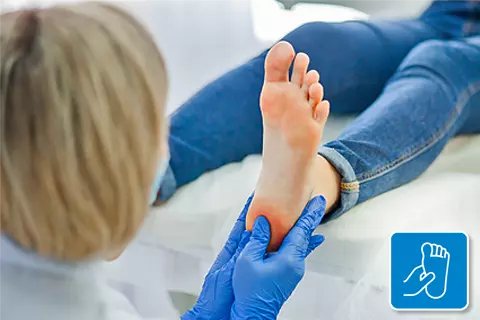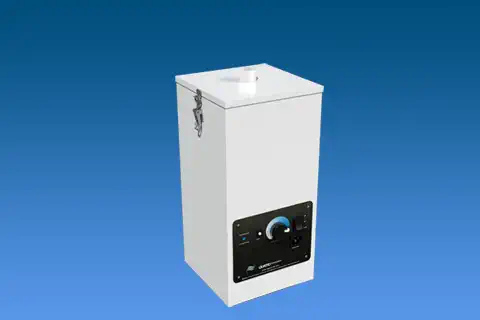Podiatry and Footcare
Overview
 Working in specialized or general clinics, podiatrists provide assessment, treatment and care for patients with a wide variety of foot concerns. Their clientele is equally diverse ranging from athletes with sport injuries to patients with chronic conditions such as gangrene, diabetic ulcers and toenail infections.
Working in specialized or general clinics, podiatrists provide assessment, treatment and care for patients with a wide variety of foot concerns. Their clientele is equally diverse ranging from athletes with sport injuries to patients with chronic conditions such as gangrene, diabetic ulcers and toenail infections.
Ranked eleventh on the Occupational Information Network (O*NET) database for most hazardous jobs, a profession in podiatry comes with a number of health risks. While podiatrists are exposed to various dangers throughout their career, the most common offenders are indoor air pollutants.
Podiatrists and foot care specialists come in contact with a number of chemicals and toxins on a daily basis that pose inhalation hazards and put them and their clients at risk for a number of infectious and chronic diseases. Their profession, in fact, is one of the most notoriously affected by poor indoor air quality (IAQ). To protect staff and clients from adverse health risks, addressing IAQ in podiatry offices is a must.
Air Quality Challenges
A career in podiatry or footcare comes with several risk factors that can adversely affect the health and wellbeing of specialists and clients. While radiation is a concern, the most common health problems plaguing podiatrists are due to exposure to indoor air pollution.
The most common contaminants affecting IAQ in podiatry offices include:
- Microbial Dust
- Bloodborne and Infectious Disease
- Chemical Hazards
- High Carbon Dioxide Levels
- Odors
Microbial Dust
Podiatrists and other footcare specialists generate microbial dust when reducing calluses and corns and drilling and filing toenails. The fine dusts produced with these practices pose inhalation hazards while the larger particulates can cause eye injuries.
Since 1972, there has been an ongoing debate whether nail dust is serious enough to be considered an occupational health hazard. Considering asthma is four times more pervasive within the industry compared to the national average and complaints of rhinitis and conjunctivitis are common, there is strong evidence indicating a likely occupational risk.
Nail dust created by drilling is estimated to be 0.8 to1.6 µm in size- small enough to be deposited deep into the lungs and stay there, not to be exhaled again. These smaller particles create an aerosol that can remain airborne for 30 minutes and negatively impact immunocompromised clients.
Within these microbial dusts are dangerous microorganisms including bacteria, Staphylococci, fungi, and yeasts and molds. Common respiratory health issues associated with these dusts include:
- Headaches
- Loss of Sense of Smell
- Respiratory Allergies
- Sinusitis
Bloodborne and Infectious Diseases
Along with microbial dust, podiatrists are at risk of contracting bloodborne diseases when drilling and scaling.
Podiatrists evaluate and treat a wide variety of clients, some of whom may carry viruses such as HIV and hepatitis B and C. When professionals use sharp scalpels for the debridement of calluses and ulcers, these viruses can become aerosolized, putting themselves at risk for infection.
Without proper air filtration, bacteria and viruses can spread and linger indoors, sometimes for hours at a time. The onset of the Covid pandemic has highlighted the need for better air filtration and ventilation. To protect staff and clients from both bloodborne and infectious disease, an effective air purifier with proper filtration is essential.
Chemical Hazards
Podiatrists are also exposed to a number of hazardous chemicals in their practice.
A typical podiatry office will use a variety of chemicals to reduce calluses and corns, decontaminate instruments, disinfect the skin and treat fungal and other infections that pollute indoor air. Inhaling fumes from cork, rubber, glues and solvents used in the manufacture of orthopedic insoles also poses a health risk.
High Carbon Dioxide Levels
Yet another factor in contributing to poor IAQ, elevated carbon dioxide levels puts staff and clients at risk for poor health outcomes. Indoor spaces with high CO2 have been shown to cause a number of adverse effects including drowsiness, fatigue, headaches, dizziness and respiratory problems.
According to the American Society of Heating, Refrigerating, Air-Conditioning Engineers (ASHRAE), CO2 concentrations should be lower than 1000 parts per million (ppm) to maintain good air quality. The American National Standards Institute (ANSI)/ American Society of Heating, Refrigerating and Air Conditioning Engineers (ASHRAE) have guidelines for ventilation system design for acceptable IAQ. Standards 62.1 and 62.2 outline minimum ventilation rates and other measures podiatry offices can take to curtail the adverse health effects of poor air quality.
Odors
Given the fact that the prime function of podiatrists is the care and treatment of foot ailments, it’s no wonder that their treatment rooms are often plagued by persistent odors. These odors can permeate throughout the office and into waiting and consultation rooms, molesting clients.
Source capture and containment systems are an effective way to reduce and eliminate unwanted odors in podiatry offices.
Solutions for the Podiatry and Footcare Industry
To reduce the inherent health risks associated with the podiatry and footcare industry, employing source capture and containment systems can be highly effective. Air purifiers help clean and bring in fresh healthy air, reducing viral transmission and chemical exposure.

Basic
Source Capture for Debris & Light Odors
With foot-pedal & unit mounted capture arm. Portable with compact space-saving design.
Part Number#: BA-FA11-A
>> View Product Details

Basic
Stationary Model
With hose & foot-pedal - unit mounted capture arm sold separately. Handle allows for easy portability.
Part Number#: BA-FA11
>> View Product Details

MedEVAC Mini
Portable Model
With capture arm, casters & foot-pedal. Excellent for for nail dust.
Part Number#: MEM-297LCN
>> View Product Details

MedEVAC Mini
Stationary Model
With 6 ft long 1.5" diameter hoses & foot-pedal. Excellent for for nail dust.
Part Number#: MEM-217LRK
>> View Product Details

Accessories
Attachments, Arms & Controls
Explore our vast selection of available accessories & attachments.
Download Accessories Brochure